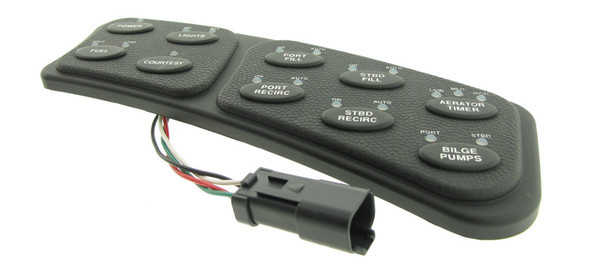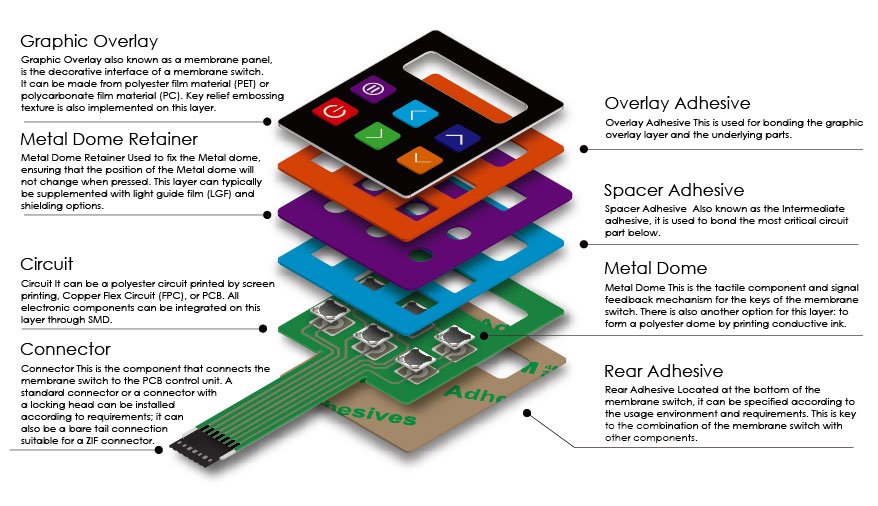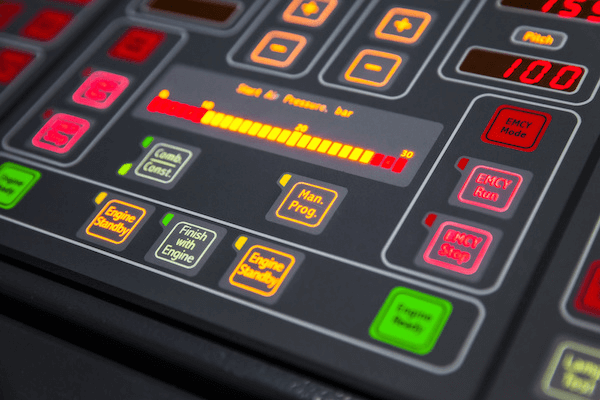The Production Process Behind Membrane Layer Change: What You Need to Know
The production process behind membrane changes combines careful style, material choice, and quality control. It starts with understanding the details of membrane layer button style and proceeds with numerous stages, including product choices and printing strategies. Each phase plays a crucial role in making certain performance and longevity. However, the intricacies of layer construction and the extensive screening standards may disclose insights that are not right away evident. What lies beyond these fundamental components?
Understanding Membrane Change Style
Membrane switches might show up straightforward at very first look, their layout includes detailed factors to consider that assure functionality and durability. The design process begins with an extensive understanding of individual demands, including the interface's desired application and ecological factors. Ergonomics is a crucial element, as the layout must facilitate convenience of use while guaranteeing that tactile feedback meets customer expectations.Moreover, the layering of parts, such as visuals overlays, sticky layers, and conductive traces, should be exactly crafted. membrane switch. This split setup not only influences the button's responsiveness however likewise affects its durability. Interest is provided to the sealing techniques used to shield against moisture and dirt, which might compromise performance. In addition, style considerations reach looks, where color pattern and visual clarity boost individual experience. Ultimately, the layout of membrane switches over equilibriums functionality, customer experience, and longevity, making sure that they meet the needs of different applications effectively
Products Used in Membrane Layer Change Production
When choosing products for membrane switch manufacturing, it is necessary to consider both efficiency and sturdiness. The key materials consist of polyester and polycarbonate films, which supply flexibility and stamina. These movies are typically covered with sticky to assure proper bonding to substratums. Conductive inks, commonly composed of silver or carbon, are essential for producing electric links within the switch, permitting for dependable operation.Additionally, a safety layer, such as a tough coat, is often put on boost scratch resistance and durability. The selection of backing material, such as acrylic or foam, can significantly affect the button's tactile feel and general customer experience. Numerous environmental elements, consisting of temperature level and humidity, ought to direct product choice to ensure peak efficiency in details applications. Ultimately, the best combination of materials adds to the membrane switch's performance and life expectancy, making notified options crucial for manufacturers.
The Printing Process: Creating Video and Text
The printing procedure in membrane layer button production plays a considerable function in creating high-grade graphics and message. Numerous visuals layout techniques are employed to assure aesthetic allure and capability, while cautious ink choice techniques are necessary for longevity and efficiency. Comprehending these aspects is fundamental for achieving best cause membrane layer button style.
Graphic Design Techniques
Graphic layout methods play an important duty in the printing process of membrane layer switches, as they specify exactly how graphics and text will inevitably appear on the end product. Reliable graphic layout includes the strategic use font styles, colors, and designs to improve readability and aesthetic charm. Developers typically make use of vector graphics for scalability, making sure that images stay sharp at various sizes. In addition, attention to comparison and placement is important, as it affects user interaction and visual top quality. The consolidation of branding components, such as logos, need to be taken care of with care to preserve brand honesty. In general, thoughtful visuals layout techniques contribute substantially to the functionality and beauty of membrane switches, influencing customer experience and product performance.
Ink Choice Approaches
Picking the appropriate ink is necessary for attaining the desired visual high quality and longevity in membrane layer switch production. Different ink kinds are made use of, consisting of solvent-based, water-based, and UV-curable inks. Each type provides unique features, such as attachment, flexibility, and resistance to environmental factors. Solvent-based inks are frequently favored for their toughness and vivid shades, while water-based inks are extra eco-friendly however may have restrictions in adhesion. UV-curable inks offer rapid curing and robust efficiency. In addition, shade matching methods guarantee that the selected inks straighten with layout requirements. Inevitably, the option of ink should consider factors such as application approach, substratum compatibility, and end-use demands to achieve remarkable cause membrane button graphics and message.
Layer Building and Assembly

Product Choice Process
A careful selection of products is essential in the manufacturing process of membrane buttons, as it directly affects capability and durability. The primary products used consist of polyester, polycarbonate, and numerous conductive inks. Polyester is usually favored for its excellent resistance to chemicals and abrasion, making it suitable for rough environments. Polycarbonate, on the other hand, offers exceptional clarity and impact resistance, which is advantageous for applications requiring visibility and effectiveness. Conductive inks, typically composed of silver or carbon, are essential for producing trusted electrical paths. In addition, the selection of sticky products influences the general stability of the switch - membrane switch. Evaluating factors such as environmental exposure, responsive feedback, and aesthetic demands guides producers in choosing the finest products for their details applications
Layer Bond Techniques
Sticking layers in membrane layer switch construction is a vital process that assures functionality and long life. Various bond techniques are utilized to safeguard suitable bonding between layers, which normally include making use of adhesives, warmth, and pressure. Pressure-sensitive adhesives (PSAs) are typically utilized for their ease of application and prompt bonding abilities. In addition, thermal bonding methods can be used, where warm is utilized to activate adhesive homes, securing a strong bond. The option of attachment technique largely depends upon the products included and the certain application needs of the membrane layer switch. Correct positioning and consistent application of adhesives are important to prevent flaws, securing the switch runs effectively throughout its intended lifespan.
Quality Control Steps
Guaranteeing quality assurance throughout the layer construction and setting up of membrane buttons is important for keeping efficiency and reliability. This process usually entails several critical procedures, consisting of comprehensive evaluations at each phase of production. Manufacturers utilize advanced screening methods, such as peel tests and attachment assessments, to verify the stability of layer bonds. Furthermore, aesthetic evaluations are conducted to determine any kind of issues in printing or product inconsistencies. Environmental conditions, such as temperature and humidity, are carefully kept an eye on to ensure suitable healing and bond. Normal calibration of tools aids preserve accurate manufacturing standards. By applying these top quality control actions, makers can significantly reduce the risk of item failure, guaranteeing that the last membrane layer changes meet the called for specs and client expectations.
Evaluating and Quality Assurance Steps

Developments in Membrane Change Innovation
As advancements in modern technology remain to evolve, membrane layer switches are profiting from innovative growths that enhance their capability and individual experience. One notable technology is the combination of capacitive touch modern technology, which enables more user-friendly and responsive user interfaces. This change not just enhances visual appeals yet also lowers mechanical wear and tear, expanding the lifespan of the switches.Additionally, improvements in graphic overlay products have brought about improved longevity and resistance to environmental aspects such as dampness and UV light. These materials currently supply enhanced clearness and illumination, further boosting the visual appeal.Furthermore, the consolidation of clever technology is transforming membrane layer switches over into interactive control panels, making it possible for connection with IoT a knockout post devices. This connectivity promotes a seamless customer experience, paving the way for applications in different sectors, from medical care to consumer electronics. Collectively, these advancements placement membrane layer switches as essential components in modern gadget style.
Often Asked Inquiries
How much time Does the Membrane Switch Manufacturing Process Take?
The duration of the membrane button production procedure can differ substantially. Variables such as intricacy, products made use of, and manufacturing quantity impact timelines, with regular manufacturing varying from a few days to several weeks for completion.
What Are the Common Applications for Membrane Buttons?
Membrane layer buttons are generally made use of in different markets, including automobile controls, family home appliances, clinical tools, and customer electronic devices (membrane switch). Their convenience and durability make them ideal for applications requiring straightforward interfaces and trustworthy efficiency in diverse atmospheres
Can Membrane Switches Over Be Customized for Details Demands?

What Is the Life-span of a Common Membrane Layer Change?
The lifespan of a regular membrane switch varies, however typically, it varies from 1 to 5 million cycles. Variables such as use, setting, and material quality significantly influence toughness and total efficiency with time.

Are Membrane Layer Switches Over Eco Pleasant?
The ecological friendliness of membrane switches over differs. Some materials used might not be recyclable, while others can be green. The total effect depends on manufacturing products and methods, necessitating careful factor to consider during selection and disposal. The Our site production process behind membrane switches over combines cautious design, product selection, and top quality control. It begins with understanding the details of membrane button style and progresses via different phases, consisting of material options and printing techniques. When picking materials for membrane layer button manufacturing, it is essential to consider both performance and longevity. A cautious option of materials is essential in the production procedure of membrane buttons, as it directly affects functionality and toughness. The option of adhesion technique greatly depends on the materials entailed and the particular application needs of the membrane switch.
Comments on “Top considerations when choosing a membrane switch for aerospace use”